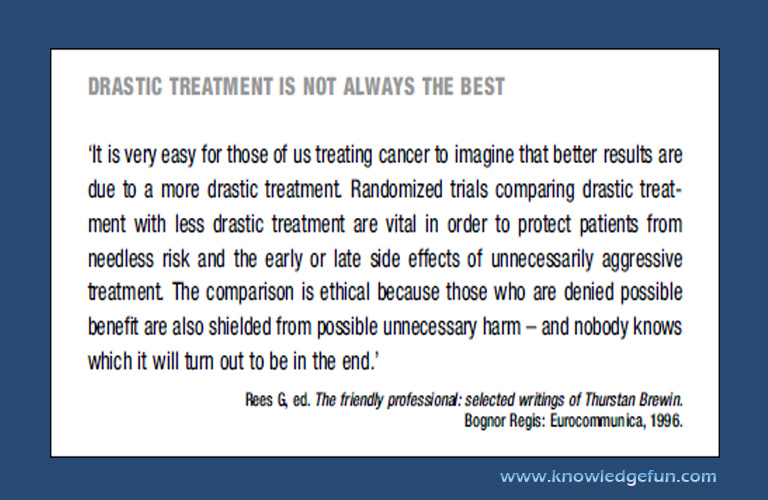Chapter II
USED BUT INADEQUATELY TESTED
In Chapter 1 we learned that some new treatments have had harmful effects that were unexpected; the hoped-for effects of others failed to materialise; and some predictions that treatments would not work were proved wrong. This chapter highlights how commonly used treatments may not have been tested adequately. How can this happen? The therapies advocated for breast cancer – which are often in the news – provide some especially valuable lessons.
WHEN MORE IS NOT NECESSARILY BETTER
Throughout the 20th century and even into the 21st, women with breast cancer have endured some exceedingly brutal and distressing treatments. These treatments – both surgical and medical – far exceeded what was actually required to tackle the disease. But they were also unquestionably popular with some patients as well as their doctors. Patients were convinced that the more radical or toxic the therapy, the more likely the disease would be conquered. It took courageous doctors and outspoken patient advocates many years to begin to turn the tide of misbelief. They not only had to produce reliable evidence to banish the myth that ‘more is better’, but also suffer the ridicule of their peers and the resistance of eminent practitioners.
Even today, fear, coupled with the belief that more must be better, drives treatment choices. This prompts some patients and their doctors to opt for ‘traditional’ mutilating and painful treatments, for which there is no evidence of benefit over simpler approaches. How can this be?
Until the middle of the 20th century, surgery was the main treatment for breast cancer. This was based on the belief that the cancer progressed in a slow and orderly manner, in the first instance from the tumour site in the breast to local lymph nodes, in the armpit, for example. Consequently it was reasoned that the more radical and prompt the surgery for the tumour, the better the chance of halting the spread of the cancer. Treatment was essentially by extensive ‘local’ surgery – that is, surgery on or near the breast. It may have been called local, but a radical mastectomy was anything but – it involved removing large areas of chest muscle and much lymph node tissue from the armpits.
However, some thoughtful and observant breast cancer specialists noted that these increasingly mutilating operations did not seem to be having any impact on death rates from breast cancer. So, they put forward a different theory – that breast cancer, rather than spreading from the breast in an orderly manner through the nearby lymph nodes, was in fact a systemic disease from the outset. In other words, they reasoned that cancer cells must already be present elsewhere in the body at the time the breast lump was detected. If so, they suggested, removal of the tumour with an adequate margin of normal tissue, plus a course of radiotherapy, would be both kinder to the woman and might be as effective as radical treatment. The introduction of ‘systemic therapies’ at about this time – that is, treatments that would deal with production or development of cancer cells elsewhere in the body – was also based on this new theory of breast cancer spread.

DRASTIC TREATMENT IS NOT ALWAYS THE BEST
‘It is very easy for those of us treating cancer to imagine that better results are due to a more drastic treatment. Randomized trials comparing drastic treatment with less drastic treatment are vital in order to protect patients from needless risk and the early or late side effects of unnecessarily aggressive treatment. The comparison is ethical because those who are denied possible benefit are also shielded from possible unnecessary harm – and nobody knows which it will turn out to be in the end.’
Rees G, ed. The friendly professional: selected writings of Thurstan Brewin.
Bognor Regis: Eurocommunica, 1996.





